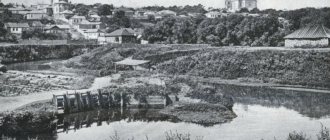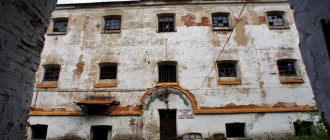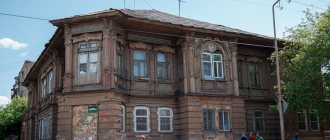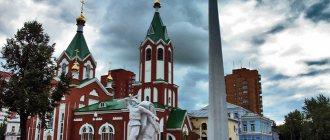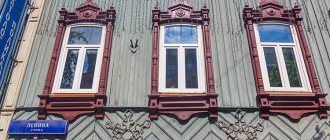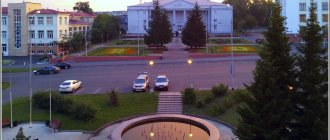Bogoroditsk is a city in Central Russia, the administrative center of the Tula region. Located on the right bank of the Upyorta River (a tributary of the Upa), 65 km southeast of Tula, 240 km south of Moscow. An ancient Russian city. In the center of the city is the Upyorta River, on the high bank of which there is the first landscape park in Russia, and in the park there is a palace-museum of the 18th century. The city has developed road services, as well as the production of clothes dryers and fumigators. Bogoroditsk is a small provincial town, divided from north to south by the Upertaya River, with a traditional radial-ring structure in its western part. Almost the entire eastern part of the city is occupied by the palace museum. The main city thoroughfare is Kommunarov Street.
Bogoroditsk History.
Founded in 1663 as a fortress on the southern borders of the Moscow state. After the construction of the temple in the name of the Intercession of the Most Holy Theotokos, it became the village of Bogoroditskoye. In the 17th-18th centuries. A busy trade route passed through Bogoroditsk, horses for transportation were supplied by the city stud farm, inns and taverns appeared. Since 1719, Bogoroditsk has been in the Tula province of the Moscow province. In 1763 it was transformed into the village of Bogoroditskoye, and from 1768 - a settlement. Since 1777, the district town of Bogoroditsk, Tula governorate (since 1796 - Tula province). In 1797-1802. - a city with no residents. During the Great Patriotic War, the city was occupied by Nazi troops on November 15, 1941. It was liberated on December 15, 1941 by troops of the Western Front during the Tula operation.
Why was Bogoroditsk called Bogoroditsk?
There is a legend that says that an icon painter monk lived in these places. Only he was not much of an artist, to put it mildly. He starts to paint the Virgin Mary or saints, but what comes out is just a daub, all the colors are mixed, the image blurs. And then one day the Mother of God appeared to him in a dream and said that when he woke up, he should go out the door and collect the grass that would grow around him. They say that all you have to do is add this herb to your paints, and the ability to paint icons will immediately appear. The monk woke up and did everything as the Mother of God ordered. The herb growing outside turned out to be thyme. Since then, thyme here began to be called the Mother of God herb, and the city itself - Bogoroditsky.
"Tula Peterhof".
The city of Bogoroditsk is often called the “Peterhof of Tula”. It received this name not at all due to its proximity to the Northern capital and access to the sea. The small town of the Tula region earned its loud unofficial name thanks to the unique palace and park complex of the Bobrinskys, which to this day delights the eyes of visitors.
Bogoroditsk (Tula region): photos and descriptions of natural attractions
In the vicinity of the city there are many villages, villages and towns, some of which are semi-abandoned and completely abandoned these days.
But this will not deprive the charm and beauty of the local nature. One of the specific features of this area is waste heaps. These are artificially created “mountains” near coal mines from exhausted rock impurities. It is enough to leave the city and carefully look around; waste heaps can be seen on the horizon, impressively towering above the surface of fields and meadows. Another unique attraction of the area is the blue lakes. The Tula region, Bogoroditsk in particular, is a center for mining. In addition to coal, sand and limestone were mined in the open pit in this area; the mined out quarries were eventually abandoned and filled with water. The resulting reservoirs delight the eye with rocky steep banks and sandy beaches, and the water in them has an incredible azure color. That is why people often call them “blue lakes”.
Bogoroditsk. History of the estate.
This estate was designed by the brilliant architect I.E. Starov for Catherine the Great and her illegitimate son Alexei Bobrinsky. The famous public figure and agronomist Andrei Bolotov created a unique man-made landscape park here. And Leo Tolstoy “settled” Vronsky from the famous novel “Anna Karenina” in this estate. Tsarevich Alexander Nikolaevich and his mentor Vasily Andreevich Zhukovsky visited Bogoroditsk during their famous trip to Russia.
Apple orchards and thyme field
To the side of the estate there is another example of the revitalization of the area. It was once part of the palace complex, but during the Soviet years it was converted into a collective farm with apple orchards, and after the collapse of the USSR they stopped caring for the place. As you understand, over the years the gardens have become a forest:
Now the site has new owners, and architects and other specialists are working on it. The first thing they did here was sanitary felling of maple trees. The bizarre shapes of apple trees became visible, reaching towards the sun through other trees.
When they began to study apple trees, it turned out that some were already more than 80 years old. Many different varieties have been preserved here: from traditional to the rarest. They are trying to rejuvenate the trees: they feed them and prune them. Each tree is given a number to know exactly what variety it is and to track and treat diseases.
Two fields have also been set up here: for new apple trees and thyme.
photo bureau "Novaya Zemlya"
Thyme is a symbol of the Virgin Mary. Nine bunches of thyme are depicted on the city's coat of arms. They plan to create hills in the fields and plant different varieties of thyme on them. The entire field is surrounded by the trees of the old park, which provides wind protection and a beautiful backdrop.
The new owners have very ambitious plans for cider brewing and eco-tourism, but that will all come later. In the video, Irina Glik talked about this in detail.
Castle.
The palace, built at the end of the 18th century according to the design of the architect Starov as the estate of Alexei Bobrinsky, is a pearl of early Russian classicism. The estate complex in Bogoroditsk became the first serious work of the novice architect, who later built the Tauride Palace and the Trinity Cathedral of the Alexander Nevsky Lavra in St. Petersburg.
"U Gashi" - home theater
Theater "U Gashi" is a home theater in Bogoroditsk. It started with the play “Carnival” based on the work of Lope de Vega, the premiere of which took place at the end of December 1987. The theater was authorized on the basis of the “Library of Arts”, which was located on the estate of Count Bobrinsky.
The theater owes its name and birth to Natalya Alekseevna Mashutina, the library manager, and Galina Anatolyevna Spesivtseva, the librarian. To brighten up the evenings, they began to stage plays and read poetry. All this took place in the library at the “Club of Lovers.” Spectators who attended this event began to call it: Home Theater “U Gashi”, after the names of the founders GALINA and NatASHI.
Bogoroditsky Park.
After the death of the empress, the estate passed to her illegitimate son, Alexei Grigorievich Bobrinsky. The luxurious Bogoroditsky Park was created at the cost of colossal efforts by the famous Russian thinker and agronomist, Andrei Timofeevich Bolotov. A unique example of landscape design was created here in the most difficult conditions and is completely man-made. This is what makes Bogoroditsk similar to the famous palace and park ensemble in Peterhof. Many famous people of that time visited Bogoroditsk, and Leo Tolstoy, who repeatedly visited the estate, described it as Vronsky’s house in his novel Anna Karenina.
Manor in modern times.
Now the Bobrinsky estate is the hallmark of the city. There is a museum in the main manor house, and everyone can take a walk in the park. The entire complex of manor buildings in Bogoroditsk can be conditionally divided into two parts: “ceremonial” buildings located on one bank of the dammed Uperta River and buildings located behind its dam and on the other bank.
Global plan
Landscaping, a pond, gardens and much more are small steps towards the big goal of revitalizing the city and boosting the economy. There is already history here and even tourists come, but they do not stimulate the development of Bogoroditsk: there is simply nowhere to eat or spend the night.
"New Earth"
Normal improvements and new points of attraction should encourage entrepreneurs to start investing money in the city. Competition for a tourist’s ruble works wonders and has the ability to open up a city—in Kolomna or Serpukhov, for example, it worked perfectly.
"New Earth"
According to the concept, there should be a circular route through the city center and the estate. Physically, it already exists, but this is not enough: it’s like with a diamond, its value appears only after good processing.
The route will bring together all the most interesting things and will raise interest in the historical heritage along it. There are several pre-revolutionary buildings preserved here, which are still empty and crumbling.
This building, for example, is generally the same age as Bolotov, judging by the archives. But they use it for advertising and storing old TVs in the yard.
For me, the weakest point in this story so far is logistics. There is a railway in the city, but there is no normal communication with Moscow or Tula. You can try to get there by bus, but it’s unlikely to go well. While a car is the most convenient way to get here, there is no point in counting on mass tourists with this option.
In principle, we have experience in solving such problems. For example, Russian Railways has been doing excellent tourist routes lately, just remember the steam locomotives to Ruskeala. But without regional support this will not be possible.
Kazan Church.
Walking along the main alley and turning left, we see a path leading to the estate church of the Virgin Mary - the Kazan Church. It was also designed by the architect Starov in the style of early classicism. The Kazan Church became one of the first major projects of the young graduate of the Russian Academy of Arts, who was destined to gain all-Russian fame.
Cathedral of the Assumption of the Blessed Virgin Mary
The cathedral was erected in the mid-19th century with the money of the Mother of God merchants. It has a look corresponding to the Empire style. Many years later, another temple of St. George the Victorious is discovered in the bell tower. Currently, the cathedral offers video rental of Christian films.
Location: 10th Army Street - 13.
Gate tower.
We return to the main alley and head towards the gate tower. It was built here in the 60-70s. XVIII century There is no information left about who was the architect of the tower. The tower served as the belfry of the Kazan estate church and was the front gate to the courtyard. In addition, the volost office was located in the tower above the gate.
Bogoroditsk appeared in 1663 by decree of Tsar Alexei Mikhailovich. The purpose of founding this settlement was to create a new grain-producing volost and populate empty lands on the southern borders of the Russian state. In the 17th century, this was still a turbulent place - even 300 years after the Battle of Kulikovo, the Crimean and Nogai Tatars made constant raids on the south-eastern lands of Russia and often broke through to Moscow. Thus, Bogoroditsk was assigned the role of a second-line fortress.
The construction of the fortress (the city in the terms of that time) proceeded slowly at first - people were not willing to go to uninhabited places and tried to return home as soon as possible. The situation changed when people began to be sent here for “eternal life” - people who could not leave this place, and by 1670 Bogoroditsk was a completely combat-ready fortress, which also had a secret passage to the river. The archers and gunners lived here, and the governor sat here.
By the beginning of the 18th century, due to the expansion of the territory of Russia, Bogoroditsk lost its role as a border fortress, and in 1715 a large stud farm was created on the site of the fortress. Somewhat later, an entrance bell tower and other buildings were built here. In 1737, the first educational institution appeared in Bogoroditsk - a school for stable children. Its main purpose was to train palace grooms and, in addition, the needs of the highway passing through the city were taken into account.
With the coming to power of Catherine II, Bogoroditsk was excluded from the staff list of the district cities of the empire, and its district was turned into a volost, which was renamed “her imperial majesty’s own” and transferred to special rule by Lieutenant General Cavalier S.V. Gagarin. The stud farm was also liquidated, so Bogoroditsk lost its only large establishment. After all the transformations, the former county town became the center of the volosts that belonged to Catherine, and the purpose of the transformations was to form possessions for the illegitimate son of Catherine II and Count G.G. Orlov - Alexei Grigorievich Sitsky (in 1775 the surname was changed to Bobrinsky).
On the territory of the former fortress, and later a stud farm, a rich estate was built for A.G. Bobrinsky, opposite which a large oval pond was dug. The palace building was located on the high left bank of the pond, on the remains of the earthen ramparts of the old fortress. The palace and the Kazan Church were made in the style of early classicism and were built according to the design of the major metropolitan architect I.E. Starova. The estate complex also included a bell tower rising behind the palace and adjacent L-shaped service buildings, which were called the “castle” and which, together with the palace, surrounded the courtyard. The volost office was located in the tower above the gate. Later, a magnificent park was laid out on the territory of the estate, the designer and creation leader of which was the outstanding Russian agronomist A.T. Bolotov, who at that time was the manager of the volost.
In 1777, Bogoroditsk again received the status of a county town, which brought great changes and revitalization to its life. Officials - several noble families - came here to serve, which marked the beginning of the emergence of a county society. Noble youth needed to study, and a boarding school was opened in the city in 1778. The knowledge that was given in this boarding school had significant gaps and, trying to correct these shortcomings, A.T. gathered the students of the boarding house twice a week. Bolotov, a person distinguished by education and versatility. The name of Bolotov is also associated with the emergence of a volost school for teaching peasant children to read and write (it was one of the first educational institutions for the people in the Tula province) and a children's theater. Despite the fact that the actors in this theater were young, serious plays were staged there. Bolotov staged plays of his own compositions and those of famous authors, and he himself participated in the creation of the scenery. The theater attracted a large number of spectators (more than 200) and played an important role in the cultural life of the city. Unfortunately, the theater did not last long: from 1779 to 1781, its existence was stopped by a big fire in the estate.
The time of 20 years of management of the volost of A.T. Bolotov (1776-1796), was a bright period in the history of Bogoroditsk, a time of its rise, especially cultural. Later, Bogoroditsk was demoted for the second time and removed from the list of district towns. However, not for long. In 1802, the county and its previous status were returned to it.
During the War of 1812, not far from Bogoroditsk, partisans recaptured a bronze column from Napoleonic troops, which Napoleon was preparing to install in Moscow in honor of his victory (Napoleon installed a bronze column in all the capitals of the occupied countries, the height of which was equal to his height). The column was delivered to the Bobrinsky Palace in Bogoroditsk. Now it can be seen in the Tula Weapons Museum on the territory of the Tula Kremlin.
In 1828, the son of A.G. Bobrinsky - Alexey Alekseevich Bobrinsky built a sugar factory in the village of Mikhailovsky. And his nephew, Alexey Pavlovich Bobrinsky, opened a sugar factory on his Bogoroditsky estate. This enterprise produced over 70 thousand granulated sugar per year, and was widely known in Russia. A.P. Bobrinsky, even before the abolition of serfdom, began to switch to civilian labor.
Thanks to the efforts of A.P. Bobrinsky Bogoroditsk is included in the railway communication system. The station opened at the end of 1874 and was named “Bogoroditsk”; later, in 1905, it was renamed “Zhdanka”. The railway brought considerable benefits to the city: it increased trade turnover, contributed to the development of production and the development of brown coal deposits, which Bogoroditsky district was rich in. In 1897, in terms of the number of inhabitants, Bogoroditsk ranked sixth in the Tula province, second only to Tula, Belev, Efremov, Krapivna and Venev. During the 19th century, the following were opened in Bogoroditsk: a district (then city) school, an agricultural school, schools and gymnasiums.
After the 1917 revolution, the Bobrinsky park and palace were nationalized. Some members of the Bobrinsky family were arrested and then released due to lack of evidence of their counter-revolutionary activities.
Denikin's attack on Moscow in 1919 forced the military revolutionary committee to allocate the palace for Red Army barracks. This was a temporary measure, but it opened up the possibility of using the palace for similar purposes in the future - internal security units were located within its walls until 1921.
Since 1919, a folk theater appeared in the city, the main director of which was A.N. Chetvertushkin, and school teachers and other representatives of the Bogoroditsk intelligentsia were actors - they worked during the day and devoted their evenings to the theater. The theater was truly popular and accessible to all. It was a huge success in the city; many performances were impossible to attend. Everything changed in 1924, when A.N. was fired. Chetvertushkin, and after him the best actors of the theater left. The new director was unable to restore the theater's former success, and in 1926 the theater building burned down.
After the end of the civil war, the economy of Bogoroditsk was in decline; only a few enterprises in the city were operating. With the beginning of industrialization in the country, the city's economy began to revive: business at the tannery went well, new enterprises appeared (brick factory, industrial plant, bakery, dairy, etc.), and mines started operating. Bogoroditsk became a small industrial city.
Unfortunately, stupidity and ignorance penetrates all layers of society, as a result of which in the city the following were destroyed: the Intercession Church, the Trinity Cathedral and the bell tower near the palace. The Assumption Church continued to operate (since 1998 - a cathedral).
The Great Patriotic War inflicted severe wounds on Bogoroditsk. The city lay in ruins, all that was left of the palace was a dilapidated box, Cererine Grove was destroyed, and the city's economy was in complete decline - as the invaders retreated, they destroyed everything they could.
But the life of the city continued. The basis of the region's economy for the first two decades after the war was the coal industry, and a mining technical school was opened in the city. In the late 60s, due to the depletion of coal resources, the mines began to close. But the closure of the mines did not become a disaster for the residents of the region - thanks to the prudent government policy, the coal industry was replaced by the electronic one.
In 1962, a plant for technochemical products was opened, and in 1965, a transformer plant (Resurs). The mining technical school is being reorganized into a technical school for electronic devices. In 1968, a light engineering plant began operating, the food industry (meat processing plant, sugar plant, dairy plant) and many other enterprises developed. There were 19 collective and state farms in the region, which provided the region with grain, sugar, milk and meat. The Bobrinsky Palace was saved from complete destruction, the bell tower was restored, the city residents replanted the Tsererina Grove, and the restoration of the Bogoroditsky Park began.
The new economic course of Russia, taken in the early 90s of the 20th century, does not affect the condition of the city for the better. Like many other small towns in the country, Bogoroditsk found itself in a difficult economic situation - well-established industries, abandoned to the mercy of fate, began to decline, over ten years the volume of gross output of the city and district decreased by 78% (that is, more than four times), in a deplorable situation turned out to be agriculture. Significantly less attention was paid to the upbringing of youth and education, and jobs with decent wages disappeared. All this gave rise to a large number of economic and social problems not only in the city, but also in the country as a whole - drunkenness, drug addiction, crime.
In the last decade, the city's economy has picked up somewhat. The factories that survived the hard times began to operate (unfortunately not all of them), large chain businesses came to the city, private entrepreneurship arose, and large agricultural enterprises began to appear in the region. But, despite this, the economy of the Bogoroditsky district remains subsidized. Unfortunately, the mentioned enterprises have not yet become the key to the successful development of the region. The city is again waiting for its revival.
Babin A.P.
Sources
Top
The front yard of the estate.
Having passed through the gate of the tower, we find ourselves in the front courtyard of the estate and we have a view of the pearl of the estate complex - the main estate house, referred to only as the palace. The eastern facade is decorated with a portico of four Tuscan columns. Columns support the second floor balcony. The building, erected on a hill above the dammed Uperta River, is a rare example of early classicism, diluted with notes of Baroque. The building does not have luxurious decoration, and yet it has a light and solemn appearance. The two-story house is decorated with a belvedere. The western façade of the palace is highlighted in the center by a semicircular projection, which defines the oval halls located inside. The palace suffered greatly during the war. All that was left of it were the walls. However, it was restored in the 60-70s of the last century and now houses a museum.
Theater city
A few years ago this very pond looked like this:
photo bureau "Novaya Zemlya"
The pond was not just a place to store water - it was the beginning of the estate, just like the preface to books. One cannot be revealed without the other. But no one has looked after the pond for years, and without sanitization, such reservoirs can only exist in the form of a swamp:
photo bureau "Novaya Zemlya"
Then a lot of work began to clean it up: to do this, the water was released several times, the excess was removed, the drainage was updated, and only after that the dam was reopened. In 2019-2020, the pond was returned to the city.
photo from the Novaya Zemlya bureau photo from the Novaya Zemlya bureau
Today it is again the center of the city, although somehow a fountain appeared at the same time:
We could have stopped there, but the story is much deeper and more interesting - the pond again became a preface to more global works. Cleaning and sanitation became possible due to the activity of citizens and patrons of the arts, but at the same time, the “New Land” bureau was working on a master plan for the city. This document was supposed to find new meanings for the old city and revitalize its economy. This is how the “city-theater” project appeared.
The next step was to improve the passage through the dam from the city to the estate. As we remember, tourists are already coming to the city, some even have weddings here, and local residents also use the park - and they all pass through this narrow passage. Previously there was a small path and overgrowth, now there is a promenade. They were able to build this by winning a federal competition for the improvement of small towns.
photo bureau "Novaya Zemlya"
The embankment was named Bolotov Boulevard. This is the entrance to the estate and the beginning of a large circular route around the pond. The first thing that catches your eye is the red interactive object “Snail”. This is a prototype of the elements that Bolotov created in his park.
The whole structure is movable, the children are delighted. Even adults can climb on it - I checked it myself with the approval of the architects. Nice view from above!
There are a lot of activities here: trampolines, swings, tables for playing chess - in general, a gentleman's set of good amenities.
The trees in the park are still young, so pergolas have been installed here for at least some shade. The color and shape of the pergolas themselves are not an accident; everything refers us to the classicism of the estate.
There are also some interesting details with the landscaping. For example, the planted apple trees refer us to the works of Bolotov: he described more than 600 varieties of apple and pear trees and developed many unique varieties. There is a Bolotovsky variety of apple tree - such trees were also planted here.
In general, landscaping is perennial and multi-layered: plants will live with the site and develop for many years. Plants also create zoning, separating transit and quiet zones. At the far end of the promenade there are many benches that are hidden by bushes and terrain. In addition, almost everywhere there is a kind of buffer of greenery behind benches and swings: plants create a feeling of security when we are swinging or sitting.
There is only a fear that local city services may not be able to maintain such beauty: this requires experience and budgets. I hope I'm worrying for nothing.
Now the embankment is missing the most important element - a floating stage. It should reflect the idea of a theater city and remind of Bolotov’s legacy: he was the first in Russia to invent and create a children’s theater in which children were the actors, and they also wrote the script. They plan to build, maintain and manage the stage using the money of entrepreneurs through a special company.
concept of the bureau "New Earth"
Bogoroditsk. How to get there.
By train to the Zhdanka station of the Tula branch of the Moscow Railway. Or go to Uzlovaya station, and then take a regular bus. By car from Moscow by car along the M4 Don federal highway (extension of Kashirskoye Highway) to Voronezh up to 240 km. By bus there is a bus station in the city. Bus routes from Moscow, Tula, Novomoskovsk. Transits from Voronezh, Kurkino. Flights from Moscow depart from Krasnogvardeyskaya metro station every two hours. Travel time from Moscow is 3 hours, travel time from Tula is 1 hour.
There are regular buses and minibuses running in the city, but due to the large traffic intervals, you should only wait for them if the walking is really difficult. All objects of interest to a traveler are within walking distance. There are many taxi drivers, they arrive quickly, but they can inflate prices. Taxi numbers: +7 (48761) 2-20-00, +7 (48761) 2-14-14, +7 (48761) 2-15-15. The cost of the trip is from 100 rubles. During the summer navigation period, you can take a boat trip along Upörta, admiring the views of the palace and park.
Bathhouse of the Bobrinsky sugar factory
Not far from the dam, near the pond, there is a red house. This is an old two-story building that formerly belonged to the sugar factory of Count Bobrinsky. On the first floor there was a bathhouse and a laundry room; the manager of the bathhouse lived on the second floor. After the factory closed in the 19th century, the building was converted into a residential building. At the beginning of the 20th century, the residents were resettled and since that time no one else has lived in the house.
The house is shrouded in legends and myths. Local residents say that people die in it and therefore try to avoid it. Now the house is in disrepair, but lovers of mysticism and the past are frequent guests there. After all, a journey into the past and revealing the secrets of the red house will not leave anyone indifferent.
